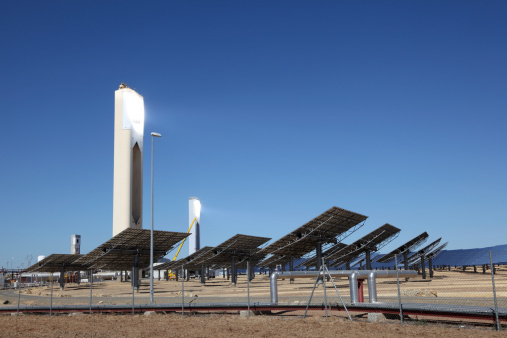A giant, state-of-the-art solar power complex in the Mojave Desert is incinerating birds and drawing close scrutiny from federal wildlife officials and environmental groups.
In operation since February, the $2.2 billion Ivanpah solar energy project has achieved notoriety far beyond the expectations of its developers, BrightSource Energy, NRG Solar, and Google. Instead of kudos for producing green energy, Ivanpah is rapidly becoming a symbol of a technology that poses a lethal threat to wildlife and a safety hazard to passenger jets using the busy Los Angeles and Las Vegas international airports.
The project was made possible by a $1.6 billion loan guarantee from the U.S. Department of Energy, as part of the Obama administration’s support of renewable energy.
300,000 Mirrors
Located on five square miles of federal land overseen by the Bureau of Land Management, Ivanpah uses 300,000 seven-by-ten-foot mirrors to redirect concentrated sunlight upward toward three 459-foot boiler towers, dubbed power towers. The water inside the towers is heated to 1,000 degrees Fahrenheit, producing steam that turns turbines to generate electricity.
The bright light created by the reflecting mirrors attracts huge numbers of insects, which in turn attract birds, and both are burned in mid-air by Ivanpah’s intense heat. Estimates of the number of bird kills vary from 1,000 a year by BrightSource to 28,000 annually by the Center for Biological Diversity.
Federal and state wildlife officials have confirmed birds flying over Ivanpah are being lethally singed, with numerous reports of puffs of smoke suddenly appearing, followed by dead birds, called “streamers,” falling to the earth. Nonetheless, the California Energy Commission is considering an application by Oakland-based BrightSource to build another mirror field with a 75-story power tower near Palen, California, between Joshua Tree National Park and the California-Arizona border. The plant would be on a flight path for birds between the Colorado River and California’s largest lake, the Salton Sea.
‘Highest Lethality Potential’
The area contains protected golden eagles and peregrine falcons as well as over 100 other species of birds. In July, U.S. Fish & Wildlife (FWS) officials warned California power-tower style solar technology holds “the highest lethality potential” of any of the solar projects planned for the Golden State’s deserts.
The July warning followed a federal report calling the Ivanpah facility a “mega-trap” for birds and recommending steps to reduce solar power tower bird deaths.
Responding to the bad publicity from Ivanpah’s bird deaths, BrightSource has proposed donating $1.8 million to programs that spay and neuter cats, claiming the program will protect birds because cats sometimes kill small birds.
In response to this proposal, Jay Lehr, Heartland Institutes science director said , “That’s like a drunk driver who caused an accident offering to pay to educate teen drivers concerning the perils of driving intoxicated rather than being punished for his crime. BrightSource’s offer may reduce bird deaths but it doesn’t make up for the birds it kills.”
The Fish & Wildlife Service remains concerned. Pete Sorenson, division chief of the FWS Palm Springs office, posted a letter on the California Energy Commission website urging extreme caution before approving more power tower projects.
“We are concerned about the increasing number of power tower projects that are proposed or undergoing permitting review, given the outstanding questions about the impacts of utility-scale application of the technology,” Sorenson wrote. “As such, it would be beneficial to the permitting process for pending and future projects, including the Hidden Hills and Rio Mesa, to gather monitoring data that answer some of the questions about avian physiological tolerance and behavioral response to power towers, from already approved projects, before approving more projects.”
Beyond merely researching the bird impacts, “we suggest that the Agencies limit the number of power tower projects that are considered for permitting and development until we obtain a more detailed understanding of this technology and its impacts, based on at least a couple years of scientifically robust monitoring,” Sorenson explained. “Deploying technology of this scale in multiple places and on a short timeframe without such an understanding compromises our ability to make informed decisions on projects that would permanently and cumulatively impact species and the extensive tracts of desert habitat upon which they depend.”
FAA Warning
Ivanpah’s power towers also interfere with aviation. The Federal Aviation Administration (FAA) has issued warnings to pilots who fly in and out of Las Vegas and other destinations in Southern California.
“For years, advocates of renewable power have touted a ‘free energy’ narrative in trying to convince the public it is possible to power the world on butterflies, rainbows, and pixie dust,” said Marita Noon, executive director of Energy Makes America Great. “What they have been trying to push on consumers is now exposed as the fairy tale it is.
“While the wind blows and the sun shines for ‘free,’ turning them into electricity is expensive—both to consumers and the avian population,” Noon explained. “There is obviously a lot of money to be made in the solar industry to enable it to offer $1.8 million in compensation for anticipated bird deaths that does nothing to help the poor birds that are instantly fried mid-flight. Where is PETA [People for the Ethical Treatment of Animals] when you need them?”
Noon concluded, “The California Energy Commission must not approve the proposed Palen Power Tower project that is projected to kill one bird every 30 seconds.”
Bonner R. Cohen, Ph. D., ([email protected]) is a senior fellow at the National Center for Public Policy Research.





